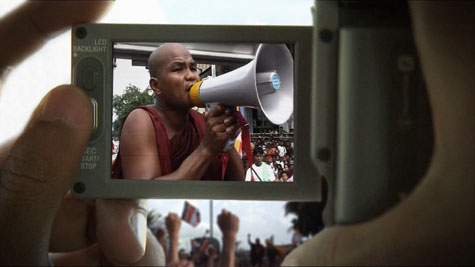
SHOWING THE WORLD What really goes on in Burma.
|
Anders Østergaard's Burma VJ: Reporting From a Closed Country is paced and edited with the keen, polished urgency of a thriller — there are frantic, confused phone conversations, along with gloomy music and a healthy amount of ominous foreshadowing — but most of its footage is shaky, off-center, and drastically pixelated, even when viewed on a television.

The crude cinematography comes courtesy of the Democratic Voice of Burma, a "station in exile" comprised of about 30 "video journalists" who covertly (often through holes in their backpacks or by concealing cameras under their armpits) shoot news stories in the closed-off, military junta-controlled nation. (Foreign journalists are largely banned from the country.) Their stories are intended both for the international community ("I feel the world is forgetting about us," one VJ says) and the people of Burma, who can only watch the stories after they are smuggled or sent through the Internet to DVB headquarters in Oslo, Norway, and beamed back to Burma via satellite. In the fall of 2007, the DVB made international headlines by capturing the first major popular uprising in Burma since 1988.
Burma VJ is narrated by "Joshua" (many names and faces in the film are concealed, to protect the journalists' identities), a DVB journalist who captured the first hints of popular discontent, after the Burmese government doubled gas prices throughout the country, without warning, on August 15, 2007. Joshua was detained by secret police when he was caught filming a small protest, and the DVB advised him to find safe haven in Thailand. There, he worked as the demonstrations swelled into a mass movement, communicating over the phone and the Internet with other journalists and Burmese monks, who colluded with the DVB to ensure the events were noticed by the international community. (The monks, Joshua says, are the "only force in Burma who can scare the military.")
Crucially, Østergaard uses Joshua's exile as a framing device; his phone and Internet conversations with the monks and other journalists are staged as dramatic reenactments, which allows Burma VJ's narrative to be told as it happened. The VJ footage, undeniably powerful by any standard, becomes extraordinarily gripping in this context; it's both inspiring (seemingly every window and rooftop in Rangoon is packed with supporters cheering on the many thousands of protesters) and harrowing (when the government cracks down on the uprising, as was expected, the impact is uniquely devastating).
Joshua's heroic action-in-exile is also a deft nod to the power of citizen journalism in the Internet era, but as necessary as Østergaard's conduit is, Joshua's isolation occasionally dulls the impact of the DVB's remarkable footage. You can sense some of the thematic import of watching the rallies in Burma from the perspective of someone outside of the country — Burma's rulers have ensured the country is detached from the world at large — but the greatest success of Burma VJ is that its video footage, however jittery and consumer-grade, is completely absorbing. That Østergaard jolts us out of that sense of wonder and urgency from time to time is a minor shame, but his film is still essential viewing, one of the most taut and likely the most important documentary of the year.
Christopher Gray can be reached at cgray@thephoenix.com.
BURMA VJ: REPORTING FROM A CLOSED COUNTRY |directed by Anders Østergaard | produced by Lise Lense-Moller | released by Oscilloscope Laboratories and HBO Documentary Films | 85 minutes | screens at SPACE Gallery June 24-25 at 7:30 pm, followed by Q&A with Burmese monks | $7 | space538.org